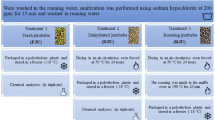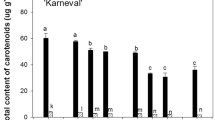Abstract
Cuticular wax is an important factor that affects storage quality of fruits and vegetables. Previous studies have shown that cuticular wax of pears changes significantly during storage, whereas there are few studies on the effects of different storage methods on the wax changes and the relationship with storage quality. Cuticular wax of Korla pear stored using different methods, was measured to analyze its total wax content, chemical compositions and their relationship with storage quality. At the end of storage, the highest cuticular wax content was observed in controlled atmosphere (CA) storage and the lowest in room temperature storage. The substances of the primary components with higher contents were nonacosane, (E, E)-ɑ-farnesene, dodecan-1-ol, 1,1-dimethoxynonane, nonanal, palmitic acid, and oleic acid. Total wax content, olefins and fatty acids were most significantly with the storage quality, followed by alkanes and esters. Moreover, total wax content, wax composition and weight loss were closely related to postharvest senescence. Overall, an understanding of variations in the cuticular wax under different storage methods could provide theoretical basis for further study on the storage and preservation technology of pears.



Similar content being viewed by others

References
Ahvenainen R (1996) New approaches in improving the shelf life of minimally processed fruit and vegetables. Trends Food Sci Technol 7:179–187
Baker EA, Bukovac MJ (2008) Characterization of the components of plant cuticles in relation to the penetration of 2,4-D. Ann Appl Biol 67:243–253
Belge B, Llovera M, Comabella E, Gatius F, Guillén P, Graell J, Lara I (2014) Characterization of cuticle composition after cold storage of 'Celeste' and 'Somerset' sweet cherry fruit. J Agric Food Chem 62:8722–8729
Cajuste JF, GonzcLlez-Candelas L, Veyrat A, Garcca-Breijo FJ, Reig-Armiclana J, Lafuente MT (2010) Epicuticular wax content and morphology as related to ethylene and storage performance of ‘Navelate’ orange fruit. Postharvest Biol Technol 55:29–35
Chen S, Li Y, Bi Y, Yin Y, Ge Y, Wang Y (2014) Solvent effects on the ultrastructure and chemical composition of cuticular wax and its potential bioactive role against Alternaria alternate in Pingguoli pear. J Integr Agric 13:1137–1145
Cheng G, Huang H, Zhou L, He S, Zhang Y, Xa C (2019) Chemical composition and water permeability of the cuticular wax barrier in rose leaf and petal: a comparative investigation. Plant Physiol Biochem 135:404–410
Chu W, Gao H, Chen H, Fang X, Zheng Y (2018) Effects of cuticular wax on the postharvest quality of blueberry fruit. Food Chem 239:68–74
Chu W, Gao H, Cao S, Fang X, Chen H, Xiao S (2017) Composition and morphology of cuticular wax in blueberry (Vaccinium spp.) fruits. Food Chem 219:436–442
Clayton M, Amos ND, Banks NH, Morton RH (1995) Estimation of apple fruit surface area. N Z J Crop Hortic Sci 23:345–349
Dong X, Rao J, Zhu S, Yang Q (2013) Combination of modified atmosphere packaging and 1-methylcyclopropene treatment suppress decreasing of wax composition of apples during cold storage. Trans Chin Soc Agric Eng 29:269–277
Dong X, Rao J, Huber D, Chang X, Xin F (2012) Wax composition of ‘Red Fuji’ apple fruit during development and during storage after 1-methylcyclopropene treatment. Hortic Environ Biotechnol 53:288–297
Dong X, Huber D, Ramirez-Sanchez M, Rao J, Lee J, Watkins C (2014) Cultivar differences in gaseous 1-methylcyclopropene accumulation in whole and fresh-cut apple fruit. Postharvest Biol Technol 93:130–134
Fan X, Mattheis JP, Blankenship S (1999) Development of apple superficial scald, soft scald, core flush, and greasiness is reduced by 1-methylcyclopropene (MCP). J Agric Food Chem 47:3063–3068
Hao S, Ma Y, Zhao S, Ji Q, Zhang K, Yang M, Yao Y (2017) McWRI1, a transcription factor of the AP2/SHEN family, regulates the biosynthesis of the cuticular waxes on the apple fruit surface under low temperature. PLoS ONE 12:e0186996
Heng W, Huang H, Li F, Hou Z, Zhu L (2017) Comparative analysis of the structure, suberin and wax composition and key gene expression in the epidermis of ‘Dangshansuli’ pear and its russet mutant. Acta Physiol Plant 39:150
Jacobs JF, Koper GJM, Ursem WNJ (2006) UV protective coatings: a botanical approach. Prog Org Coat 58:166–171
Ju Z, Bramlage WJ (2001) Developmental changes of cuticular constituents and their association with ethylene during fruit ripening in ‘Delicious’ apple. Postharvest Biol Technol 21:257
Kissinger M, Tuvia-Alkalai S, Shalom Y, Eevagi F, Elkind Y, Jenks MA, Goodwin MS (2005) Characterization of physiological and biochemical factors associated with postharvest water loss in ripe pepper fruit during storage. J Am Soc Hortic Sci 130:735–741
Klein B, Thewes FR, Rogério de Oliveira A, Brackmann A, Barin JS, Cichoski AJ, Wagner R (2019) Development of dispersive solvent extraction method to determine the chemical composition of apple peel wax. Food Res Int 116:611–619
Krauss P, Markstädter C, Riederer M (1997) Attenuation of UV radiation by plant cuticles from woody species. Plant, Cell Environ 20:1079–1085
Lara I, Belge B, Goulao LF (2014) The fruit cuticle as a modulator of postharvest quality. Postharvest Biol Technol 87:103–112
Li Y, Yin Y, Chen S, Bi Y, Ge Y (2014) Chemical composition of cuticular waxes during fruit development of Pingguoli pear and their potential role on early events of Alternaria alternata infection. Funct Plant Biol 41:313–320
Li F, Min D, Song B, Shao S, Zhang X (2017) Ethylene effects on apple fruit cuticular wax composition and content during cold storage. Postharvest Biol Technol 134:98–105
Li D, Cheng Y, Guan J (2019a) Effects of 1-methylcyclopropene on surface wax and related gene expression in cold-stored 'Hongxiangsu' pears. J Sci Food Agric 95:2438–2446
Li F, Min D, Ren C, Dong L, Shu P, Cui X, Zhang X (2019b) Ethylene altered fruit cuticular wax, the expression of cuticular wax synthesis-related genes and fruit quality during cold storage of apple (Malus domestica Borkh. c.v. Starkrimson) fruit. Postharvest Biol Technol 149:58–65
Lindow SE, Brandl MT (2003) Microbiology of the phyllosphere. Appl Environ Microbiol 69:1875–1883
Liu X et al (2017) Experimental study of leaf wax n-alkane response in winter wheat cultivars to drought conditions. Org Geochem 113:210–223
McDonald R, Nordby H, McCollum T (1993) Epicuticular wax morphology and composition are related to grapefruit chilling injury. HortScience 28:311–312
Müller C, Riederer M (2005) Plant surface properties in chemical ecology. J Chem Ecol 31:2621–2651
Neinhuis C, Barthlott W (1997) Characterization and distribution of water-repellent, self-cleaning plant surfaces. Ann Bot 79:667–677
Ning B, Kubo Y, Inaba A, Nakamura R (1991) Ripening characteristics of Chinese pear Yali fruit on and off the tree. J Jpn Soc Hortic Sci 60:703–710
Nordby HE, McDonald RE (2002) Relationship of epicuticular wax composition of grapefruit to chilling injury. J Agric Food Chem 39:957–962
Parsons EP et al (2012) Fruit cuticle lipid composition and fruit post-harvest water loss in an advanced backcross generation of pepper (Capsicum sp.). Physiol Plant 146:15–25
Peschel S, Franke R, Schreiber L, Knoche M (2007) Composition of the cuticle of developing sweet cherry fruit. Phytochemistry 68:1017–1025
Pollard M, Beisson F, Li Y, Ohlrogge JB (2008) Building lipid barriers: biosynthesis of cutin and suberin. Trends Plant Sci 13:236–246
Premakumari S (1989) Official methods of analysis of the association of official analytical chemists. Indian J Nutr Diet 26:312
Rios J, Robledo F, Schreiber L, Zeisler V, Lang E, Carrasco B, Silva H (2015) Association between the concentration of n-alkanes and tolerance to cracking in commercial varieties of sweet cherry fruits. Sci Hortic 197:57–65
Saito M, Rai DR (2005) Qualitative changes in radish (Raphanus spp.) sprouts under modified atmosphere packaging in micro-perforated films. J Food Sci Technol 42:70–72
Sala JM (2000) Content, chemical composition and morphology of epicuticular wax of Fortune mandarin fruits in relation to peel pitting. J Sci Food Agric 80:1887–1894
Saladié M et al (2007) A reevaluation of the key factors that influence tomato fruit softening and integrity. Plant Physiol 144:1012–1028
Schulmana Y, Monselisea SP (1970) Some studies on cuticular wax of citrus fruits. J Hortic Sci Biotechnol 45:471
Sharma P, Kothari SL, Rathore MS, Gour VS (2018) Properties, variations, roles, and potential applications of epicuticular wax: a review. Turk J Bot 42:135–149
Shepherd T, Griffiths DW (2006) The effects of stress on plant cuticular waxes. New Phytol 171:469–499
Slinkard K, Singleton VL (1977) Total phenol analysis: automation and comparison with manual methods. Am J Enol Vitic 28:49–55
Tang Y, Li Y, Bi Y, Wang Y (2017) Role of pear fruit cuticular wax and surface hydrophobicity in regulating the prepenetration phase of Alternaria alternata. Infect J Phytopathol 165:313–322
Tano K, Oulé MK, Doyon G, Lencki RW, Arul J (2007) Comparative evaluation of the effect of storage temperature fluctuation on modified atmosphere packages of selected fruit and vegetables. Postharvest Biol Technol 46:212–221
Verardo G, Pagani E, Geatti P, Martinuzzi P (2003) A thorough study of the surface wax of apple fruits. Anal Bioanal Chem 376:659–667
Veraverbeke E, Lammertyn J, Saevels S, Nicolai B (2001) Changes in chemical wax composition of three different apple (Malus domestica Borkh.) cultivars during storage. Postharvest Biol Technol 23:197–208
Vilas-Boas EVdB, Kader AA (2006) Effect of atmospheric modification, 1-MCP and chemicals on quality of fresh-cut banana. Postharvest Biol Technol 39:155–162
Vioqu J, Pastora J, Vioque E (1994) Leaf wax alkanes in the genus coincya. Phytochemistry 36:349–352
Wei J, Qi X, Guan J, Zhu X (2011) Effect of cold storage and 1-MCP treatment on postharvest changes of fruit quality and cell wall metabolism in sweet cherry. J Food Agric Environ 9:118–122
Weng H, Molina I, Shockey J, Browse J (2010) Organ fusion and defective cuticle function in a lacs1lacs2 double mutant of Arabidopsis. Planta 231:1089–1100
Wu X et al (2017) Chemical composition, crystal morphology and key gene expression of cuticular waxes of Asian pears at harvest and after storage. Postharvest Biol Technol 132:71–80
Wu X et al (2018) Chemical composition and crystal morphology of epicuticular wax in mature fruits of 35 pear (Pyrus spp.) cultivars. Front Plant Sci 9:679
Yin Y et al (2011) Chemical composition and antifungal activity of cuticular wax isolated from Asian pear fruit (cv. Pingguoli). Sci Hortic 129:577–582
Zeisler-Diehl V, Mueller Y, Schreiber L (2018) Epicuticular wax on leaf cuticles does not establish the transpiration barrier, which is essentially formed by intracuticular wax. J Plant Physiol 227:66–74
Zhou L et al (2013) Rice OsGL1-6 is involved in leaf cuticular wax accumulation and drought resistance. PLoS ONE 8(5):e65139
Acknowledgements
This study is supported by the National Natural Science Foundation of China (3156100295).
Author information
Authors and Affiliations
Contributions
All authors contributed to the study conception and design. YW analyzed the data and wrote the manuscript. SS and HM carried out the experiment. GC contributed to sample preparation. YJ designed the study and supervised the project. All authors read and approved the manuscript.
Corresponding author
Ethics declarations
Conflict of interest
On behalf of all authors, the corresponding author states that there is no conflict of interest.
Additional information
Publisher's Note
Springer Nature remains neutral with regard to jurisdictional claims in published maps and institutional affiliations.
Rights and permissions
About this article
Cite this article
Wang, Y., Su, S., Chen, G. et al. Relationship Between Cuticular Waxes and Storage Quality Parameters of Korla Pear Under Different Storage Methods. J Plant Growth Regul 40, 1152–1165 (2021). https://doi.org/10.1007/s00344-020-10176-3
Received:
Accepted:
Published:
Issue Date:
DOI: https://doi.org/10.1007/s00344-020-10176-3



